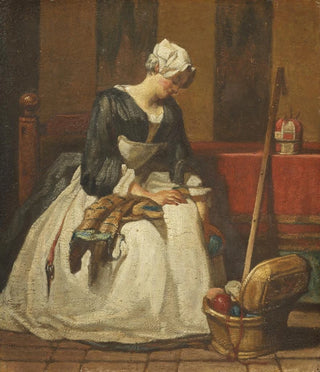Art print | The Embroideress - Jean Siméon Chardin


View from behind

Frame (optional)
In the vast panorama of art history, certain works stand out for their ability to capture moments of everyday life with rare emotional depth. "The Embroiderer" by Jean Siméon Chardin is one of these masterpieces, a painting that transcends the simple genre of portraiture to offer a reflection on intimacy and contemplation. This masterpiece, created in the 18th century, evokes an atmosphere of serenity and delicacy, where the figure of the young embroiderer harmoniously integrates into her environment. Through this painting, Chardin invites us to explore the beauty of daily gestures and to appreciate the meticulousness of artisanal work.
Style and uniqueness of the work
Chardin's style is characterized by a particular attention to detail and a subtle use of light. In "The Embroiderer," the composition is carefully orchestrated, highlighting the figure of the young woman, focused on her work. The soft colors, ranging from pastel tones to deeper shades, create a warm and welcoming atmosphere. The texture of the fabrics, the brightness of the embroidery threads, and the peaceful expression of the protagonist are all elements that testify to Chardin's unmatched talent for depicting domestic life with such delicacy. The work also stands out for its realistic approach, far from the idealized representations of the time, thus offering an authentic glimpse into the life of women in the 18th century.
The artist and his influence
Jean Siméon Chardin, an emblematic figure of the Rococo movement, managed to establish himself through his unique style and artistic vision. Born in 1699 in Paris, he dedicated his career to exploring themes of still life and genre scenes. Chardin was a pioneer in representing everyday life, influencing many artists with his ability to transform ordinary subjects into works of art of great depth. His introspective approach and attention to detail paved the way for a new way of seeing the world, where every gesture, every object, carries meaning. "The Embroiderer" is a perfect example of this philosophy, illustrating how art can serve as a mirror to society and emotions.

Matte finish

View from behind

Frame (optional)
In the vast panorama of art history, certain works stand out for their ability to capture moments of everyday life with rare emotional depth. "The Embroiderer" by Jean Siméon Chardin is one of these masterpieces, a painting that transcends the simple genre of portraiture to offer a reflection on intimacy and contemplation. This masterpiece, created in the 18th century, evokes an atmosphere of serenity and delicacy, where the figure of the young embroiderer harmoniously integrates into her environment. Through this painting, Chardin invites us to explore the beauty of daily gestures and to appreciate the meticulousness of artisanal work.
Style and uniqueness of the work
Chardin's style is characterized by a particular attention to detail and a subtle use of light. In "The Embroiderer," the composition is carefully orchestrated, highlighting the figure of the young woman, focused on her work. The soft colors, ranging from pastel tones to deeper shades, create a warm and welcoming atmosphere. The texture of the fabrics, the brightness of the embroidery threads, and the peaceful expression of the protagonist are all elements that testify to Chardin's unmatched talent for depicting domestic life with such delicacy. The work also stands out for its realistic approach, far from the idealized representations of the time, thus offering an authentic glimpse into the life of women in the 18th century.
The artist and his influence
Jean Siméon Chardin, an emblematic figure of the Rococo movement, managed to establish himself through his unique style and artistic vision. Born in 1699 in Paris, he dedicated his career to exploring themes of still life and genre scenes. Chardin was a pioneer in representing everyday life, influencing many artists with his ability to transform ordinary subjects into works of art of great depth. His introspective approach and attention to detail paved the way for a new way of seeing the world, where every gesture, every object, carries meaning. "The Embroiderer" is a perfect example of this philosophy, illustrating how art can serve as a mirror to society and emotions.






